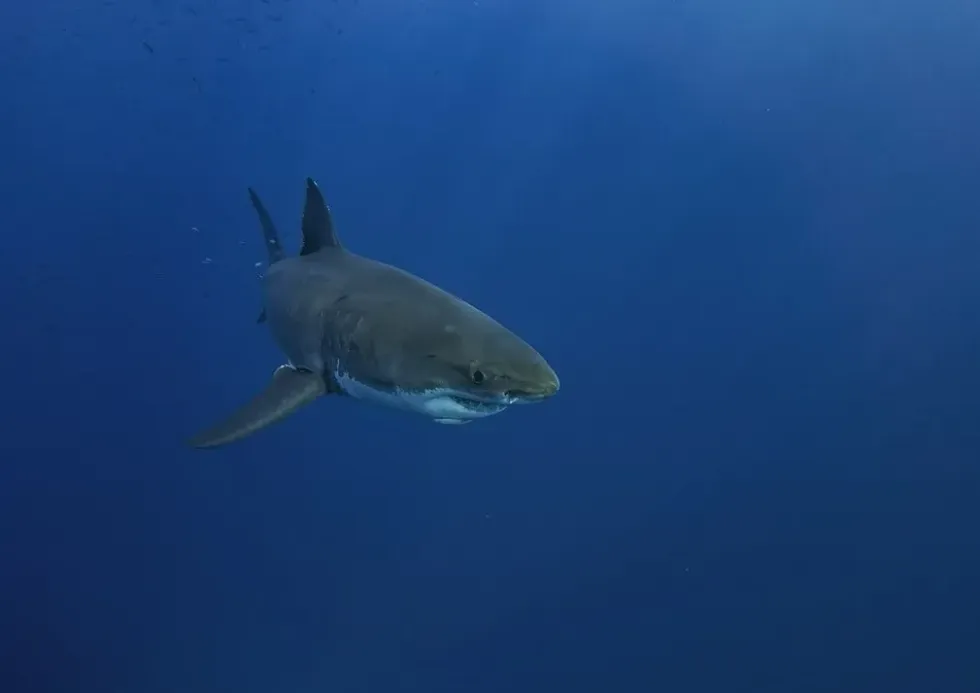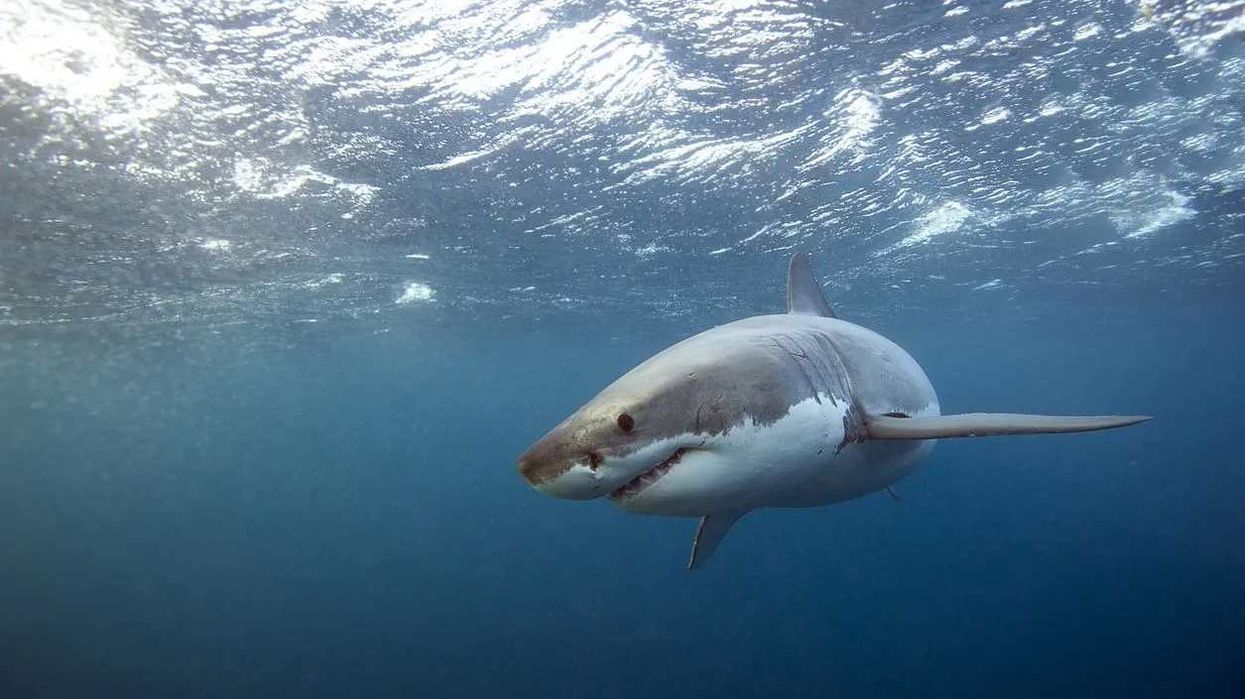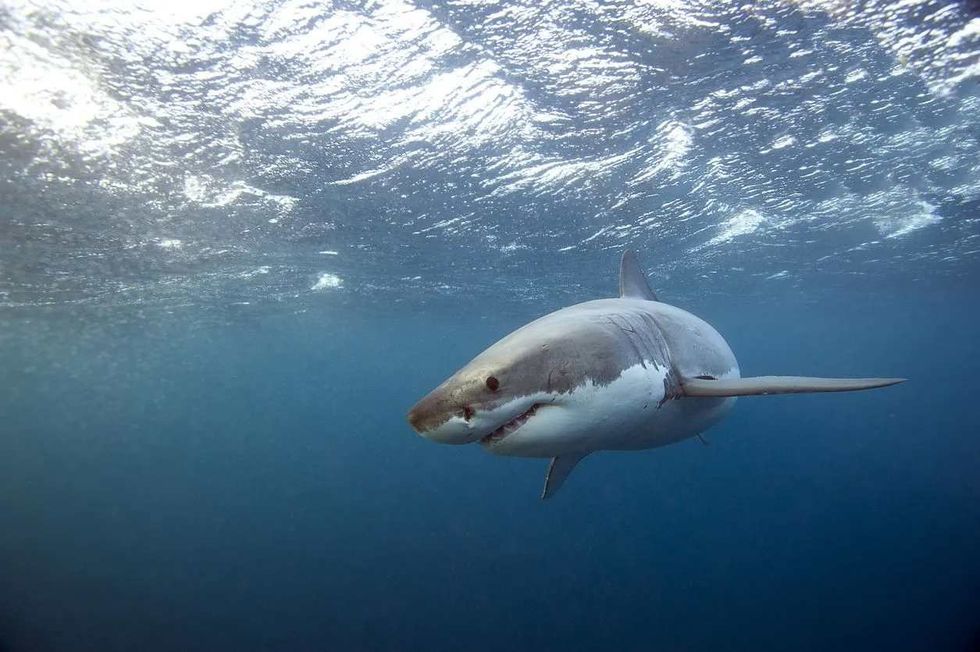Fun Great White Shark Facts For Kids

The great white shark, the world's largest predatory fish, is also known as the white shark, white pointer, or simply great white. It is a species of large mackerel shark that can be found in the coastal surface waters of all the major oceans.
Great white sharks are known to have no natural predators other than killer whales on very rare occasions.
Great white sharks eyes are of a very beautiful blue color, and the iris being is a magnificent dark blue. As per reports, the great white shark bite has a force of over 4000 PSI, which combined with their sharp teeth makes them lethal predators who can kill any prey with a single bite.
Although you shouldn't worry too much, great white sharks only attack humans if they feel threatened.
As per the International Game Fish Association, the world's biggest great white shark that has ever been recorded, weighed around 2663 lb (1207 kg). Their favorite prey includes seals, sea lions, and other small sharks.
The great white shark, being on the top of the food chain, is the most recognized extant species in the genus Carcharodon.
There are different ecological challenges, such as overfishing and poaching, that have resulted in a call for the international protection of great white sharks. Great white sharks have the habit of living in almost all of the coastal and offshore waters that have water temperatures with greater concentrations.
Due to poaching and other human activities, the numbers of great whites have been steadily declining over the last few years, which is a great cause for concern.
After you are done reading facts about great white sharks, you may also read nurse shark facts and basking shark facts to know more about the water babies in our animal kingdom.
Great White Shark Interesting Facts
What type of animal is a great white shark?
Although often mistaken for a mammal, great white sharks are a type of fish. Great white sharks qualify to be the largest predatory fish to be found on Earth.
Great white sharks are the most powerful predatory sharks in the world, and it's normal to be a little scared of these animals. Great white sharks are a special type of fish as their body is made of cartilage.
Usually, fish bodies are made out of bones, so this is quite unusual. These sharks are regarded as one of the world's most powerful marine animals and they sit comfortably at the top of the food chain.
What class of animal does a great white shark belong to?
Great white sharks, (with the scientific name Carcharodon carcharias), belong to the family of cartilaginous fishes. Great whites belong to this class as their body is made up of cartilage instead of bones like other fishes.
The great shark is also known as the epipelagic fish, and is used in the presence of rich game. Great white sharks prey on marine mammals that are heavy in weight and weigh several hundred pounds.
These apex predators prey on marine animals such as sea lions, seals, and other fish species. They have also been recorded to eat other small sharks, but this is not common at all.
How many great white sharks are there in the world?
There are only 3,500 great white sharks that are left in the wild. There has been a tremendous decline in the number of great white sharks, and their conservation status is listed as Vulnerable by the IUCN.
The great white sharks are in need of protection, and some conservation efforts are being put into trying to save these beautiful animals. Some of the countries where they are spotted the most have banned great white shark fishing, while others continue to harvest them from the oceans.
Where does a great white shark live?
Great white sharks can be found in the oceans near New Zealand, Australia, Northern Japan, and Southern Africa. It all depends on their migration status.
What is a great white shark's habitat?
The great white's preferred habitat is temperate coastal waters that are highly productive. They also enjoy offshore waters, which are defined by the abundance of fishes and marine mammals that the sharks can eat. Keeping a great white shark in captivity is not really a good idea, there were trials that occurred in the 1970s but these failed.
Who do great white sharks live with?
Great white sharks are known as mavericks and loners, as they are free thinkers and spend much of their time alone. Whenever great white sharks swim together, they try to avoid conflict and dominance battles. It is believed that there are some places, such as the waters around Africa, where great white sharks show a distinct hierarchy.
How long does a great white shark live?
The great white shark lifespan is said to be of around 70 years or more depending on different factors, these can include environmental factors, surroundings, food and nutrition that is required by their bodies, and many other factors such as poaching and fishing that can cause their lifespan to decrease.
They are one of the longest-lived cartilaginous fishes which are currently known to people.
How do they reproduce?
There is no confirmed documentation on the mating of the male and female great white sharks but it is believed that it is similar to the fertilization of most other sharks. The male is known to insert its claspers into the cloaca origin of the female, and the reproduction is viviparous.
When the mating begins, the male shark will mount a female shark, while either swimming beside or underneath.
Scientists have found that female sharks can reproduce even without having sex. The offspring that is born does not have paternal DNA.
What is their conservation status?
The conservation status of great white sharks is classed as Vulnerable by the IUCN, as great whites can be attacked or harmed, either physically or emotionally. Great white sharks need to be protected, and some of the countries have banned great white shark fishing, while others continue to harvest them from the oceans.
There is an utter need to protect the great white sharks as their numbers are declining over the years.
Great White Shark Fun Facts
What do great white sharks look like?
Great white sharks are bulky fishes that are huge in size and have a blunt torpedo. Great white sharks have different features like conical snouts that are sharply pointed, pectorals which are large, and also dorsal fins.
The belly of the great white sharks is whitish in color. Great white shark teeth are made of rows of over 300 triangular teeth. The great white sharks also have a pattern that is contrasting, and includes colors such as dark blue and gray on their back and sides.

How cute are they?
Great white's appearance is very cute. Great whites feel emotions and love as much as humans do. Great whites are usually solitary creatures and are not friendly in nature.
How do they communicate?
Great white sharks can’t make any noise and so they use their body language to communicate with each other. Great white sharks open their jaws, nodding their heads, and arch their bodies which can be a social signal of two sharks talking to each other.
Great whites also have a very strong sense of smell which is how they can detect their prey.
How big is a great white shark?
The great white shark length differs based on their sex. Female great sharks are 176-250 in (14.7-20.9 ft), and male great sharks are 134-160 in (11.2-13.4 ft) in length. Female great white sharks are usually bigger than male great white sharks. They are also the largest species of mackerel sharks that we know of.
How fast can a great white shark swim?
Great white sharks can swim at a speed of 35 mph (56 kmph). Great white sharks spend half of their time in shallow waters, which are less than 150 in (15 ft deep).
How much does a great white shark weigh?
Great white sharks are usually heavy in weight and weigh around 1150-2460 lb (521-1115 kg). The weight of great white sharks usually differs, according to the nutrition that is required for their body. Some of them weigh less, and some of them weigh more. The largest great white shark weighed 2663 lb (1207 kg).
What are the male and female names of the species?
There is no specific name for the male and female species of the great white sharks. Great whites are simply known as great white sharks.
What would you call a baby great white shark?
A baby white great shark is called a pup. Great whites are fairly large in size and are 60 in (5 ft) long when they are born. Female great white sharks, the mother of the pups, don’t care for the pup after they are born and sometimes even end up eating them.
What do they eat?
The great white shark diet includes earless seals, other sharks, crustaceans, mollusks, and sea birds. Great whites also eat small-toothed whales, sea lions, and sea turtles. Great whites eat various types of fish and other marine mammals as well.
Are they dangerous?
Although they are considered dangerous, great white shark attacks are very rare. Their bite is more likely to be fatal.
It is believed that great white sharks attack humans when they seem to be confused or curious. Great white sharks are dangerous as they are one of the most efficient predators on Earth. Some of the great white sharks are aggressive, and it may also lead to a violent reaction or attack, when they feel threatened.
Would they make a good pet?
Great white sharks are a protected species across the world, therefore, great whites cannot be kept in homes by humans. Great white sharks are the most feared animals in the water. Instead of having great white sharks as pets, you can have smaller sharks which are typically viable as pets.
Did you know...
Great white sharks are very curious in nature and often poke their head out of the water just to see what is happening, which is a behavior called spy-hopping. Great whites are one of the few fish species that pay attention to what is happening outside the water.
Therefore, it is easy for scientists across the world to identify these sharks as their fins are unique even without using tags.
Great white sharks are fast, long-distance swimmers. The first country to protect great white sharks was South Africa. Great white sharks use coloring and their speed to hunt for their predators. Great white sharks get their name from the white underbellies that they have.
Great white sharks have the capability of adjusting their body temperature and can make themselves a lot warmer than their surroundings. This ability of a higher body temperature is possible due to a phenomenon called counter current heat exchange.
You can easily draw a great white shark by making a giant oval shape, and then adding triangle shapes to act as the fins. Great whites have nearly 300 teeth, and each tooth is roughly 2 in (5 cm) in size.
How big is a great white shark's liver?
The great white shark’s liver is unusually large, and makes up 5-25 percent of their total body weight. It also takes up almost 90 percent of the space inside the body cavity. The liver is known to be the predator’s largest organ and is about 1,000 lb (453 kg). 90 percent of the liver’s weight comprises of liquid fat.
How high can a great white shark 'jump'?
Research shows the great white shark jumping up to 96-120 in (8-10 ft) above the water. Great whites are known to jump high out of the water because of the way their body is designed.
Here at Kidadl, we have carefully created lots of interesting family-friendly animal facts for everyone to discover! Learn more about some other fish including swai fish, or Caribbean reef shark.
You can even occupy yourself at home by drawing one of our great white shark coloring pages.
We Want Your Photos!
More for You
See All
Bachelor of Science specializing in Human Anatomy

Joan AgieBachelor of Science specializing in Human Anatomy
With 3+ years of research and content writing experience across several niches, especially on education, technology, and business topics. Joan holds a Bachelor’s degree in Human Anatomy from the Federal University of Technology, Akure, Nigeria, and has worked as a researcher and writer for organizations across Nigeria, the US, the UK, and Germany. Joan enjoys meditation, watching movies, and learning new languages in her free time.
Bachelor of Law

Abdulqudus MojeedBachelor of Law
A versatile professional with a passion for creative writing and technology. Abdulqudus is currently pursuing his Bachelor of Law from the University of Lagos and has experience as a tutor, intern assistant, and volunteer. He possesses strong organizational skills and is a detail-oriented person.
Disclaimer
1) Kidadl is independent and to make our service free to you the reader we are supported by advertising. We hope you love our recommendations for products and services! What we suggest is selected independently by the Kidadl team. If you purchase using the Buy Now button we may earn a small commission. This does not influence our choices. Prices are correct and items are available at the time the article was published but we cannot guarantee that on the time of reading. Please note that Kidadl is a participant in the Amazon Services LLC Associates Program, an affiliate advertising program designed to provide a means for sites to earn advertising fees by advertising and linking to Amazon. We also link to other websites, but are not responsible for their content.
2) At Kidadl, we strive to recommend the very best activities and events. We will always aim to give you accurate information at the date of publication - however, information does change, so it’s important you do your own research, double-check and make the decision that is right for your family. We recognise that not all activities and ideas are appropriate for all children and families or in all circumstances. Our recommended activities are based on age but these are a guide. We recommend that these ideas are used as inspiration, that ideas are undertaken with appropriate adult supervision, and that each adult uses their own discretion and knowledge of their children to consider the safety and suitability. Kidadl cannot accept liability for the execution of these ideas, and parental supervision is advised at all times, as safety is paramount. Anyone using the information provided by Kidadl does so at their own risk and we can not accept liability if things go wrong.
3) Because we are an educational resource, we have quotes and facts about a range of historical and modern figures. We do not endorse the actions of or rhetoric of all the people included in these collections, but we think they are important for growing minds to learn about under the guidance of parents or guardians.







